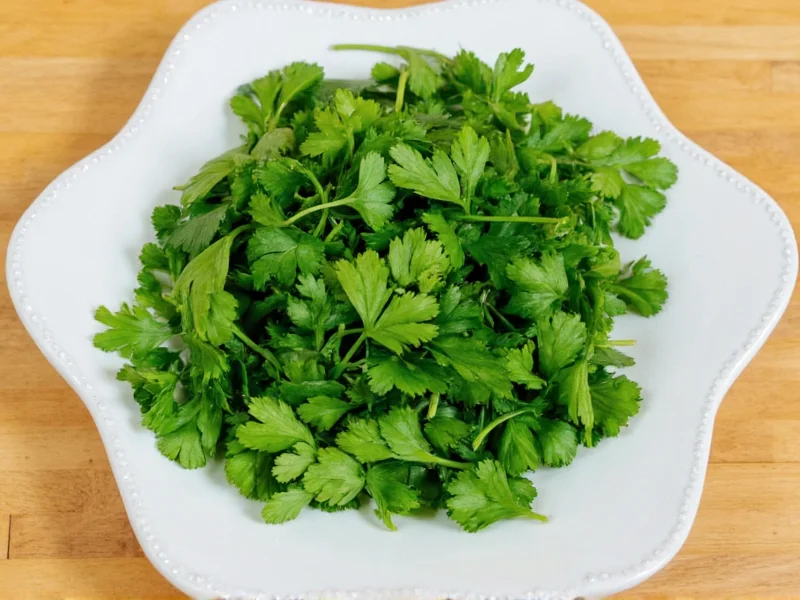Understanding Cilantro and Parsley: More Than Just Leafy Greens
When facing an empty herb container mid-recipe, the question can I substitute cilantro for parsley becomes urgent. While both belong to the Apiaceae family, their culinary roles differ dramatically. This guide provides evidence-based substitution advice from professional chefs and food scientists, helping you make informed decisions without compromising your dish.
Flavor Profile Comparison: Why Substitution Isn't Simple
Parsley (both curly and flat-leaf varieties) serves as a culinary background player with its mild, slightly peppery taste. Chefs call it the "workhorse herb" for good reason—it enhances without dominating. Cilantro, however, makes a bold statement with its intense citrus-pine flavor profile containing aldehydes that trigger soapy perceptions in genetically predisposed individuals.
| Characteristic | Parsley | Cilantro |
|---|---|---|
| Primary Flavor Notes | Grassy, mildly peppery, fresh | Citrusy, pine-like, soapy (for some) |
| Culinary Role | Neutral enhancer, color accent | Flavor centerpiece |
| Best Used In | Mediterranean, French, American dishes | Mexican, Thai, Indian, Vietnamese dishes |
| Heat Tolerance | Maintains flavor when cooked | Loses potency quickly with heat |
| Substitution Ratio | N/A | 1:1 only in compatible dishes |
When Cilantro Works as a Parsley Substitute
Successful substitution depends entirely on your recipe's flavor architecture. Consider using cilantro instead of parsley in these specific scenarios:
1. Latin American Salsas and Guacamole
When asking can I use cilantro instead of parsley in salsa, the answer is not just yes—it's preferable. Traditional pico de gallo and guacamole rely on cilantro's bright notes. If substituting in reverse (parsley for cilantro), you'll lose authentic flavor but gain a milder profile that some prefer.
2. Asian Stir-Fries and Noodle Dishes
For Thai curry pastes or Vietnamese pho garnish, cilantro brings the expected citrus dimension. Substituting parsley here creates an acceptable but inauthentic result. The reverse substitution (cilantro for parsley) works better in these applications than in Western dishes.
3. Bean Dishes and Hearty Stews
In robust preparations like black bean soup or chickpea stews, cilantro can replace flat-leaf parsley when used sparingly. The key is adding cilantro at the very end of cooking to preserve its volatile oils, whereas parsley withstands longer cooking times.
When Substitution Fails Completely
Certain dishes absolutely require parsley's specific flavor profile. Never substitute cilantro for parsley in:
Gremolata and Tabbouleh
These Middle Eastern and Italian preparations rely on parsley's clean finish. Cilantro's dominant flavor would overwhelm the delicate balance in tabbouleh's bulgur salad or gremolata's lemon-garlic harmony.
Fines Herbes and French Sauces
Classic French cuisine uses parsley as part of the fines herbes blend (with chives, tarragon, and chervil). Cilantro's aggressive flavor would destroy the subtle synergy essential to béarnaise and other delicate sauces.
Seafood Dishes Where Parsley Shines
When preparing substitute fresh cilantro for flat leaf parsley in fish recipes, you risk flavor conflict. Parsley complements seafood without competing, while cilantro's strong profile often clashes with delicate ocean flavors.
Professional Substitution Strategies
Chefs employ these techniques when forced to substitute cilantro for parsley:
- Reduce quantity by 25-50% - Start with less cilantro than the recipe specifies for parsley
- Add at the very end - Cilantro loses flavor rapidly with heat exposure
- Balance with acid - A squeeze of lime can help integrate cilantro's boldness
- Consider leaf texture - Curly parsley provides crunch that cilantro lacks
Better Alternatives When Parsley Is Unavailable
Before reaching for cilantro as a parsley substitute, consider these more compatible options:
- Chervil - Offers similar mildness with subtle anise notes
- Chives - Provides color and mild onion flavor
- Arugula - For salads, use young leaves in 1:1 ratio
- Celery leaves - Surprisingly parsley-like in flavor and texture
Genetic Factors in Herb Perception
Approximately one-fifth of people possess the OR6A2 gene variant that interprets cilantro's aldehydes as soap-like. If you're among them, substituting cilantro for parsley creates an entirely different sensory experience than intended. This genetic difference explains why substitution advice varies across cultures and individuals.
Final Verdict: Strategic Substitution Guidelines
The question can I substitute fresh cilantro for parsley requires context-specific answers:
- ✅ Do substitute in Mexican, Thai, or Indian dishes where bold flavors are expected
- ⚠️ Substitute cautiously in bean dishes or hearty stews using reduced quantities
- ❌ Never substitute in Mediterranean salads, French sauces, or delicate seafood preparations











 浙公网安备
33010002000092号
浙公网安备
33010002000092号 浙B2-20120091-4
浙B2-20120091-4